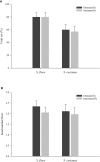Unusual patterns of hybridization involving two alpine Salvia species: Absence of both F1 and backcrossed hybrids
- PMID: 36330249
- PMCID: PMC9623266
- DOI: 10.3389/fpls.2022.1010577
Unusual patterns of hybridization involving two alpine Salvia species: Absence of both F1 and backcrossed hybrids
Abstract
Natural hybridization plays an important role in speciation; however, we still know little about the mechanisms underlying the early stages of hybrid speciation. Hybrid zones are commonly dominated by F1s, or backcrosses, which impedes further speciation. In the present study, morphological traits and double digest restriction-site associated DNA sequencing (ddRAD-seq) data have been used to confirm natural hybridization between Salvia flava and S. castanea, the first case of identification of natural hybridization using combined phenotypic and molecular evidence in the East Asian clade of Salvia. We further examined several reproductive barriers in both pre-zygotic and post-zygotic reproductive stages to clarify the causes and consequences of the hybridization pattern. Our results revealed that reproductive isolation between the two species was strong despite the occurrence of hybridization. Interestingly, we found that most of the hybrids were likely to be F2s. This is a very unusual pattern of hybridization, and has rarely been reported before. The prevalence of geitonogamy within these self-compatible hybrids due to short distance foraging by pollinators might explain the origin of this unusual pattern. F2s can self-breed and develop further, therefore, we might be witnessing the early stages of hybrid speciation. Our study provides a new case for understanding the diversification of plants on the Qinghai-Tibet Plateau.
Keywords: RAD-seq; Salvia; ethological isolation; hybridization; reproductive isolation barriers; speciation.
Copyright © 2022 Chang, Zhao, Xiao, Liu, Huang, Wei and Ma.
Conflict of interest statement
The authors declare that the research was conducted in the absence of any commercial or financial relationships that could be construed as a potential conflict of interest.
Figures





Similar articles
-
On the persistence of reproductive barriers in Eucalyptus: the bridging of mechanical barriers to zygote formation by F1 hybrids is counteracted by intrinsic post-zygotic incompatibilities.Ann Bot. 2016 Sep;118(3):431-44. doi: 10.1093/aob/mcw115. Epub 2016 Jul 10. Ann Bot. 2016. PMID: 27401540 Free PMC article.
-
Natural hybridization between two butterfly bushes in Tibet: dominance of F1 hybrids promotes strong reproductive isolation.BMC Plant Biol. 2021 Mar 10;21(1):133. doi: 10.1186/s12870-021-02909-7. BMC Plant Biol. 2021. PMID: 33691631 Free PMC article.
-
The natural hybridization between species Ligularia nelumbifolia and Cremanthodium stenoglossum (Senecioneae, Asteraceae) suggests underdeveloped reproductive isolation and ambiguous intergeneric boundary.AoB Plants. 2021 Mar 4;13(2):plab012. doi: 10.1093/aobpla/plab012. eCollection 2021 Apr. AoB Plants. 2021. PMID: 33796247 Free PMC article.
-
Species divergence with gene flow and hybrid speciation on the Qinghai-Tibet Plateau.New Phytol. 2022 Apr;234(2):392-404. doi: 10.1111/nph.17956. Epub 2022 Jan 30. New Phytol. 2022. PMID: 35020198 Review.
-
Homoploid hybridization of plants in the Hengduan mountains region.Ecol Evol. 2019 Jun 23;9(14):8399-8410. doi: 10.1002/ece3.5393. eCollection 2019 Jul. Ecol Evol. 2019. PMID: 31380098 Free PMC article. Review.
Cited by
-
Spatiotemporal Variations in Nectar Robbing and Its Effects on Reproduction in Salvia castanea Diels (Lamiaceae).Plants (Basel). 2025 Jul 23;14(15):2266. doi: 10.3390/plants14152266. Plants (Basel). 2025. PMID: 40805615 Free PMC article.
References
-
- Anderson E. (1948). Hybridization of the habitat. Evolution 2, 1–9. doi: 10.2307/2405610 - DOI
-
- Anderson E., Anderson B. R. (1954). Introgression of Salvia apiana and Salvia mellifera . Ann. Mo. Bot. Gard. 41, 329–338. doi: 10.2307/2394589 - DOI
-
- Arnold M. L. (1997). Natural hybridization and evolution. New York: Oxford Univ. Press, 113–181.
LinkOut - more resources
Full Text Sources

